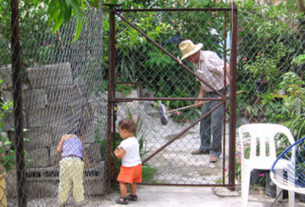While on a recent trip through the central plain states of Mexico I was having one of those evenings where I was too beat to get dressed up for dinner and I wasn’t really that hungry but I needed to eat something. As usual, I took to the streets in search of tacos.
Now, a lot of people think that tacos consist of a pre-packaged “shell” which one stuffs with ground beef and tops with Americana cheese, tomato, lettuce and salsa from a jar. The truth is, I have yet to see anything like that in Mexico. What I have seen – and tasted, however, is some of the most delicious food you can imagine coming from little hole in the wall taco stands.
Before I go any further, I don’t want you to think that I am a proponent of eating off of every little cart that goes by. I do take the time to make sure the place looks clean and, whenever possible, get recommendations from the locals in each town into whose taco stands I venture.
A basic taco (if such a thing exists) is made up of a soft tortilla (or two depending on whose making them), a filling, toppings and one or more salsas. The most common filling used in the central plain states is pork. This can be pork loin, butt, cheek, intestine, brains, shank, etc. When in doubt, ask for “tacos de carnitas”, these are made from finely chopped pork loin, shoulder, shank or butt and will not include any disgusting parts.
Another favorite made from pork are “tacos al pastor”. The meat is sliced thinly, seasoned, skewered and roasted for ever on a special rotisserie. You will know these right away because there is usually a piece of pineapple on the very top of the skewer for flavor/tenderizing purposes. These tacos are served with their own “special” sauce and, when made properly, are the best thing you could ever hope to taste.
Other common fillings for tacos include “carne asada” (fried beef), “bistek” (seasoned fried pork cutlets), “lengua” (tongue – normally either pork or lamb) and “cabeza” (meat from the head area – this usually does not include eyeballs, brains, etc. but is favored because of its higher fat content and thus moister meat).
Tacos are served flat and etiquette calls for you to fold them and eat them with your hands, something of a messy experience for the novice. An experienced taco eater is one who can eat a taco without leaving a trace on his tie or shirt.
There are multiple variations of the taco. These include “sopes” – a tortilla made thicker than normal and hollowed out in the center with edges all around, which is then fried and stuffed; “gorditas” – a tortilla also made thicker than usual but cut in half like a pita and stiffed with avariety of fillings; and the “huarache” – an oblong shaped taco which is neither folded nor eaten with the hands.
These taco variations are commonly filled with “picadillo” (minced meat with vegetables), “frijoles” (refried beans), “papa” (potatoes – mashed with tomatoes and onions), “rajas” (green chiles cooked with tomatoes and onions) and “requeson” (a cheese similar to a dry cottage cheese).
Toppings for all of these “tacos” can include lettuce, cabbage, radishes, onion, cilantro (fresh coriander), guacamole, “salsa fresca”, green salsa, red salsa, grilled onions, grilled chiles, jalapeños, pickled vegetables “queso fresco” (farmer’s cheese) and cooked beans.
Although tacos are probably not something the American Heart Association would recommend as a healthy part of your diet, they are quite tasty and form an important part of Mexico’s history and culture. So, the next time you visit, be sure to try at least one of the many varieties the country has to offer.


